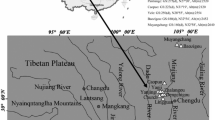Abstract
The variation in time and energy allocation of female great tits, Parus major, was studied in five different European populations across a latitudinal gradient. Daily energy expenditure (DEE) was measured in females tending 12-day-old broods. The number of daylight hours used by the parents to collect food for the brood increased with latitude, while DEE and feeding rate per brood tended to level off with latitude. Individual variation in DEE could be explained by variation in ambient temperature (–), the duration of activity period (+) and area, but not by brood size, female body mass, brood mass or feeding rate. When the effect of ambient temperature and the duration of the activity period on the day of energy expenditure measurements were controlled for, female DEE still tended to level off with latitude. Temperature and activity alone can thus not explain the observed pattern. The present study suggests that parents at southern latitudes may be under a time constraint and do not increase energy expenditure because they have no more daylight hours available for foraging, while birds at northern latitudes may be under an energy constraint because they do not make full use of the long daylight period available.
Similar content being viewed by others
Author information
Authors and Affiliations
Additional information
Received: 25 May 1999 / Accepted: 08 September 1999
Rights and permissions
About this article
Cite this article
Sanz, J., Tinbergen, J., Moreno, J. et al. Latitudinal variation in parental energy expenditure during brood rearing in the great tit. Oecologia 122, 149–154 (2000). https://doi.org/10.1007/PL00008842
Issue Date:
DOI: https://doi.org/10.1007/PL00008842




